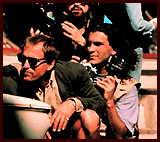Director of photography, Daf Hobson, teams up with director, Michael Winterbottom, on a hazardous shoot to film a docudrama about the seige of Sarajevo and the heroic struggle by its citizens to hold on to life despite the atrocities of war.
Making a film in Sarajevo, even after the signing of the Dayton Peace Accords, carried risks not normally associated with movie making. Sniper and mortar attacks no longer sent people scurrying for cover, but the continuing threat of landmines kept everybody a bit nervous, even Bosnians who had lived with the danger for the past six years. But Daf Hobson, director of photography on Welcome to Sarajevo, says he would return to the Balkan capital in a minute.
"It's quite a humbling experience being in the company of people who have simply survived," he remarks, speaking by phone from his home off the coast of Wales. "It was wonderful making the film and just being there."
Welcome to Sarajevo, the first picture to be shot in Bosnia since the war's end (pre-production commenced within a few days of the cease-fire), tells the powerful story of a British war correspondent who becomes emotionally involved in his assignment and ends up adopting a Muslim orphan. Based on ITN news reporter Michael Nicholson's autobiographical book Natasha's Story, it recounts how Nicholson (Henderson in the picture, played by British actor Stephen Dillane) smuggled nine-year old Natasha out of Sarajevo. In the critical role of the orphan, director Michael Winterbottom cast Emira Nusevic, a ten-year old Sarajevan native who had never acted before but who, like her screen counterpart, had lived through the three-and-a-half year siege of the city he even renamed Natasha's character after her, Emira.
This film marks Hobson's feature debut, although he has worked with Winterbottom four times before, on the British television dramas Strangers, Under the Sun, Family (for which the cameraman earned a British Academy Award) and Go Now, which will be released theatrically in the United States.
Raised in Wales, Hobson attended art college in Leeds, England, where he spent most of his extra-curricular time lighting gigs at the student union, as well as theatrical productions at the nearby Leeds Playhouse. Several television jobs followed, including a stint at Granada Television where he worked as an assistant to George Jesse Turner, long time cameraman for the British television documentary series World in Action.
Winterbottom wanted to shoot the entire picture in Sarajevo but the insurance company balked and the production was allowed only three weeks there. The rest of the movie was filmed in Croatia and Macedonia, two less volatile republics of the former Yugoslavia. Everything was shot on location, including interiors. An abandoned industrial site in Macedonia became the orphanage while a hotel in Croatia, used as a refugee center during the war, substituted for the Sarajevo Holiday Inn.
Hobson used some local crew but brought his key people with him, explaining, "I like constancy around me. The team has a signature; it has a language." For the past five years he has worked almost exclusively with the same team of Andy Long (Gaffer) and Martin Healey (Best Boy). John Robinson was key grip and Ollie Tellet was second focus puller and loader.
The movie was shot during the summer and when Winterbottom went on his original reconnaissance he found clear, blue skies. When he and the rest of the production showed up to actually shoot the film, however, clouds and haze blanketed the area. "For the entire three weeks," says Hobson with a laugh. "There isn't a lot you can do about it, so we just shot it the way it was. You can't create massive sunlight over vast areas, certainly not in Sarajevo because the equipment just wasn't there to do it. But you can shoot against the sun if it is breaking through, to increase the contrast. And if it's completely cloudy you can shoot in the direction that is most colorful."
[ continued on page 2 ]
